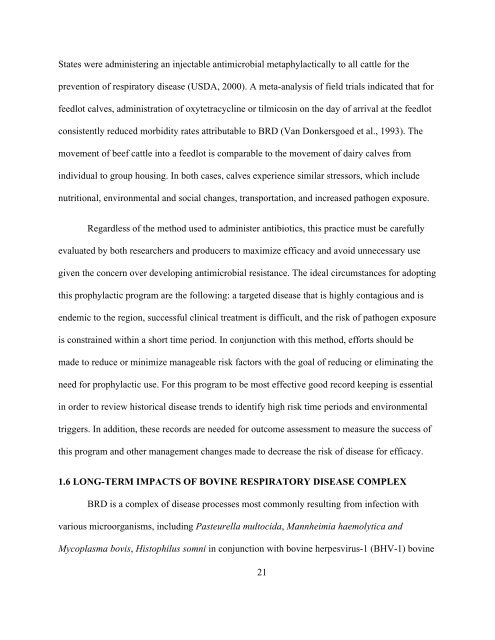Stanton PhD Thesis final_docx - Atrium - University of Guelph
Stanton PhD Thesis final_docx - Atrium - University of Guelph
Stanton PhD Thesis final_docx - Atrium - University of Guelph
Create successful ePaper yourself
Turn your PDF publications into a flip-book with our unique Google optimized e-Paper software.
States were administering an injectable antimicrobial metaphylactically to all cattle for the<br />
prevention <strong>of</strong> respiratory disease (USDA, 2000). A meta-analysis <strong>of</strong> field trials indicated that for<br />
feedlot calves, administration <strong>of</strong> oxytetracycline or tilmicosin on the day <strong>of</strong> arrival at the feedlot<br />
consistently reduced morbidity rates attributable to BRD (Van Donkersgoed et al., 1993). The<br />
movement <strong>of</strong> beef cattle into a feedlot is comparable to the movement <strong>of</strong> dairy calves from<br />
individual to group housing. In both cases, calves experience similar stressors, which include<br />
nutritional, environmental and social changes, transportation, and increased pathogen exposure.<br />
Regardless <strong>of</strong> the method used to administer antibiotics, this practice must be carefully<br />
evaluated by both researchers and producers to maximize efficacy and avoid unnecessary use<br />
given the concern over developing antimicrobial resistance. The ideal circumstances for adopting<br />
this prophylactic program are the following: a targeted disease that is highly contagious and is<br />
endemic to the region, successful clinical treatment is difficult, and the risk <strong>of</strong> pathogen exposure<br />
is constrained within a short time period. In conjunction with this method, efforts should be<br />
made to reduce or minimize manageable risk factors with the goal <strong>of</strong> reducing or eliminating the<br />
need for prophylactic use. For this program to be most effective good record keeping is essential<br />
in order to review historical disease trends to identify high risk time periods and environmental<br />
triggers. In addition, these records are needed for outcome assessment to measure the success <strong>of</strong><br />
this program and other management changes made to decrease the risk <strong>of</strong> disease for efficacy.<br />
1.6 LONG-TERM IMPACTS OF BOVINE RESPIRATORY DISEASE COMPLEX<br />
BRD is a complex <strong>of</strong> disease processes most commonly resulting from infection with<br />
various microorganisms, including Pasteurella multocida, Mannheimia haemolytica and<br />
Mycoplasma bovis, Histophilus somni in conjunction with bovine herpesvirus-1 (BHV-1) bovine<br />
21

















